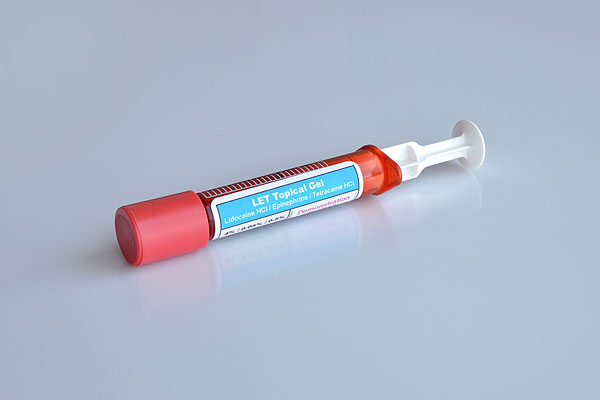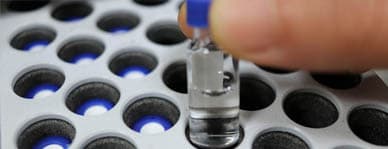LET Topical Anesthetic

Edge Pharma is proud to provide LET Gel to hospital emergency departments, urgent care centers, pediatrician offices, and other qualified health care providers. LET Gel is a topical anesthetic consisting of Lidocaine, Epinephrine, and Tetracaine which is commonly applied to open wounds prior to suturing.
Our LET Gel is dispensed in convenient 3mL unit dose amber syringes. Each dose is individually labeled to minimize the possibility of misadministration. Whether you are in charge of the inventory in a very busy emergency department or you have an independent pediatric practice that would like to keep a few doses on hand, Edge can meet your needs. As an FDA-Registered 503B Outsourcing Facility we are able to dispense LET Gel without requiring patient names.
LET Topical Gel
Single dose amber syringe for topical use, 3mL per syringe.
Storage: refrigerated
- Lidocaine 4%
- Epinephrine 0.05%
- Tetracaine 0.5%
Literature Review
Lacerations are a common cause of trips to the emergency department. In the U.S. between 7 and 9 million patients come to the ER each year because of a laceration, accounting for over 8 percent of all ER visits, according to a study published in Clinical and Experimental Emergency Medicine.(1)“The goals of laceration management include achieving hemostatic closure and optimizing cosmetic outcome without increasing the risk of infection and other complications.”(1)
“Children are particularly susceptible to experiencing high levels of pain and anxiety during routine emergency procedures such as laceration repair.”(2) A randomized, placebo-controlled trial included 221 children between the ages of three months and 17 years. The patients all came to the emergency room with lacerations requiring closure. Patients either received lidocaine-epinephrine-tetracaine (LET) or placebo prior to wound closure. The following results were reported:
“Children who received the analgesic before wound closure reported less pain (median 0.5, interquartile range [IQR] 0.25–1.50) than those who received placebo (median 1.00, IQR 0.38–2.50) as rated using the color Visual Analogue Scale (p=0.01) and Faces Pain Scale – Revised (median 0.00, IQR 0.00–2.00, for analgesic v. median 2.00, IQR 0.00–4.00, for placebo, p < 0.01). Patients who received the analgesic were significantly more likely to report having or to appear to have a pain-free procedure (relative risk [RR] of pain 0.54, 95% confidence interval [CI] 0.37–0.80).”(3)
The study also reported that complete hemostasis of the wound was more common in patients who had received LET than those who received placebo, 78.2 percent versus 59.3 percent.(3)
Topical anesthetics such as LET are frequently used with pediatric patients and not as commonly used in adults. A chart review of 89 patients (with a mean age of 33) was published in Clinical and Experimental Emergency Medicine. The review found that only 24 percent of those receiving LET before a procedure required additional anesthesia.1 “A Cochrane review of 25 randomized controlled trials totaling 3,278 patients compared topical versus infiltrated anesthetics and found that topical anesthetics had no complications and provided effective pain control, with some individual studies suggesting similar efficacy to local anesthesia.”(1)
(1) Otterness, K., Singer, A., Clinical and Experimental Emergency Medicine, Updates in Emergency Department Laceration Management, https://www.ncbi.nlm.nih.gov
(2) Lambert, C., Goldman, R., Canada Family Physician, Pain Management for Children Needing Laceration Repair, https://www.ncbi.nlm.nih.gov
(3) Harmon, S. et al, Journal of the Canadian Medical Association, Efficacy of Pain Control with Topical Lidocaine-Epinephrine-Tetracaine During Laceration Repair With Tissue Adhesive in Children: A Randomized Controlled Trial https://www.cmaj.ca
References
Principles of Office Anesthesia: Part II. Topical Anesthesia KUNDU, M.D., Scripps Clinic, San Diego, California. SURAJ ACHAR, M.D., University of California, San Diego, School of Medicine, La Jolla,California.Am Fam Physician. 2002 Jul 1;66(1):99102
https://www.aafp.org/afp/2002/0701/p99.html
“Today, pain can be effectively alleviated for such procedures as cryotherapy, shave biopsy, and curettage of molluscum contagiosa. Procedures such as laceration repair, which at one time required the use of painful infiltrative anesthetics, can now be accomplished safely and comfortably with the use of topical anesthetics. An additional advantage of topical anesthetics in laceration repair is that wound margins are not distorted.”
“For analgesia to nonintact skin, LET gel is generally preferred over TAC because of its superior safety record and cost-effectiveness.”
“Both the solution and the gel have been safely used in children older than two years of age, and both forms are equally effective.”
Register To Order Online
We are currently licensed to sell to all US states except Alabama and Virginia. Our online system makes ordering quick and easy. Just submit the simple form below to setup an account with Edge. Medical, DEA, or hospital pharmacy licenses will be required to order LET Gel.
Create an account to order
Log-In if you have an account

